
At first you might think of a kissing bug and say “ahh, they like to kiss you”. Uh… No. They actually bite you on or near your lips and drink your blood, while you sleep. Then they poop on your mouth and leave. How rude! They can also carry a parasite that causes a potentially deadly disease. Still think they’re cute? Didn’t think so. They are typically found in South and Central America, particularly in poor, rural areas. But the bug has also been found in the lower 2/3 of the U.S., typically in Texas, New Mexico, and Arizona.
First the Stats…
Scientific name: Triatominae
Length: Up to 1.25 inches
Lifespan: Up to 1 year
Now on to the Facts!
1.) Triatomine bugs are nocturnal (active at night) insects that like to bite humans on the face and lips while they’re sleeping.
2.) What’s fun about these insects is that they can also fly and are attracted by lights. So, leaving your porch lights on, sleeping with a night light, and more can attract them to your home.
3.) They are attracted to CO2 as well. Just something to keep in mind, you mouth breather, you.
4.) If you think you’re been bitten, feasted upon during the night, kissed by a parasite, as it were; you should try to capture the insect and take it in for identification and get treated right away.
5.) These parasites are also known as conenose bugs or vampire bugs.
But wait, there’s more on the kissing bug!
6.) Trypanosoma cruzi is the parasite that causes Chagas disease. Chagas disease causes fatigue, fever, body aches, loss of appetite, diarrhea, vomiting, a swelling of the eyelids on the side of the face that was bitten.
7.) Once you have Chagas disease, you are not contagious under typical circumstances. However, transmission from mother to child, and from blood transfusions, and organ transplants can spread the disease.
Did you know…?
Up to 30% of the bitten people will develop chronic Chagas disease, which can lead to heart and brain damage which can then end up causing death in young children or the immune compromised. This can happen years after the initial bite!
8.) The risk of picking up Chagas is low in the U.S. The CDC estimates that about 300,000 people in the United States carry the parasite responsible for the disease.
9.) Chagas can lay dormant in the body for decades, undetected!
10.) 2 medicines (benznidazole & nifurtimox) are nearly 100% effective in curing the disease, but only if it’s caught in the 1st stage of the disease.
Now a Short Kissing Bug Video!
Also, check out the Critter Science YouTube channel. Videos added frequently!
Want to suggest a critter for me to write about? Let me know here.



